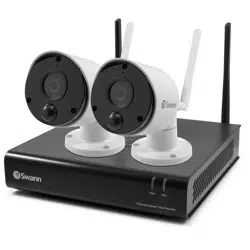Loading ...
Loading ...
Loading ...

Click for contents
67
Glossary
3D-Noise Filter: Is an enhanced form of digital noise reduction. The ad-
vancement in technology enables noise to be filtered even more effectively
from the image, even in low light conditions.
50Hz: Is the mains frequency used in the UK, Australia and most European
countries.
60Hz: Is the mains frequency used in the United States, Canada and some
Latin American countries.
AGC (Automatic Gain Control): In low light conditions, the camera will auto-
matically boost the gain control so that people and objects can be seen more
clearly. The advantage of this technique is that your camera will produce im-
ages in much lower light conditions. The downside is that the amplification
will increase the video noise visible.
AHD: Is an analogue high definition closed-circuit television video surveil-
lance standard that uses coax cable to transmit HD video from security cam-
eras to DVRs. AHD supports 720p and 1080p HD video resolutions.
Anti-flicker: As fluorescent lighting operates at the same frequency as your
mains power, this will cause luminance flicker when viewed through the
camera. Enabling the anti-flicker options available can reduce or eliminate
the flicker that is visible.
Anti-smearing: A smear effect means that a bright vertical line originating
from a bright light source appears in the image. This happens especially with
back lighting. Enabling this allows people and objects to be seen correctly
against a very bright background.
Auto DNS (Domain Name System): A service that stores domain names and
translates them into internet protocol addresses. For example, www.google.
com will have a DNS server address that is equivalent to 74.125.224.72. The
DNS server is automatically provided by your internet service provider.
Auto-focus: Will adjust the lens of your camera to focus on an object being
viewed.
Bandwidth: In computer networks, bandwidth is used as a synonym for data
transfer rate, the amount of data that can be carried from one point to an-
other in a given time period (usually a second). Network bandwidth is usually
expressed in bits per second (bps).
Bitrate: The amount of data that your DVR or NVR will use to record video.
The higher the bitrate, the more space each recording will consume on the
hard drive. Increasing this will also consume more bandwidth when stream-
ing. Unit of measurement is either Mbps (megabits per second) or kbps (kilo-
bits per second).
BLC (Back Light Compensation): Improves exposure of an object that is in
front of a light source. It does this by splitting the whole image into different
regions, and then applying separate exposure levels to those regions.
Brightness: This changes how light the image appears to be. Its value is dif-
ferent in darkness to that in daylight. For example, the lights from car head-
lights appears to be brighter at night.
CDS: This allows the image to be set by the camera’s light sensor. A CDS sen-
sor is basically a resistor that changes its resistive value (in ohms) depending
on how much light is shining onto the sensor.
Cloud: Cloud computing is a model for delivering information technology ser-
vices in which resources are retrieved from the internet through web-based
tools and applications rather than a direct connection to a server. Services
such as Dropbox, Google Drive and Microsoft OneDrive are just some of the
examples of cloud computing.
Loading ...
Loading ...
Loading ...
